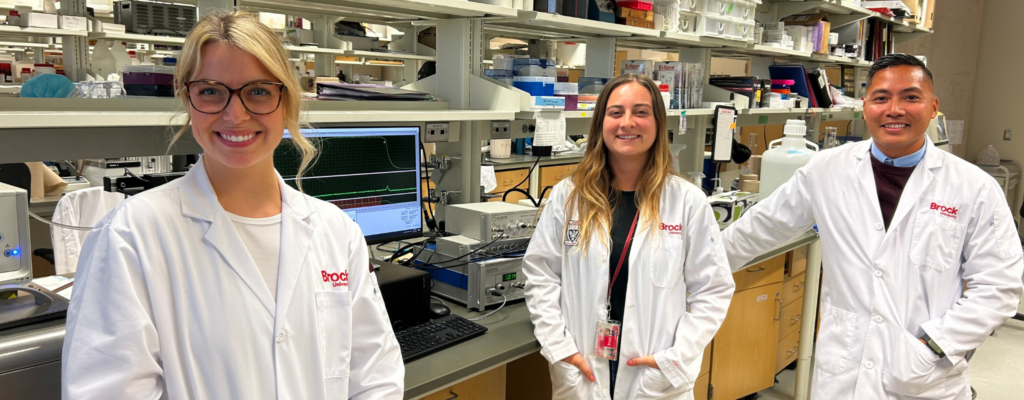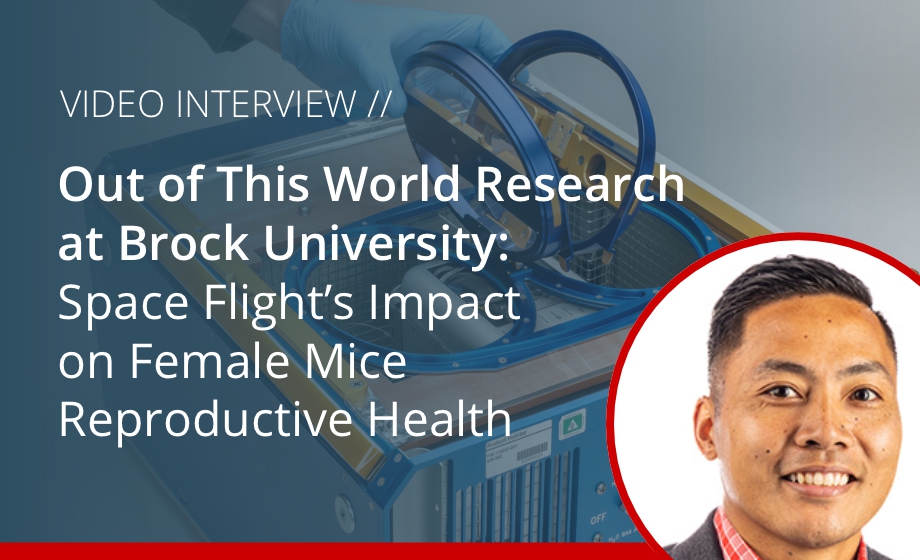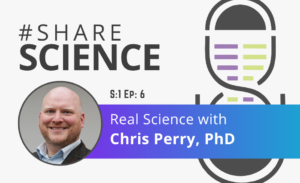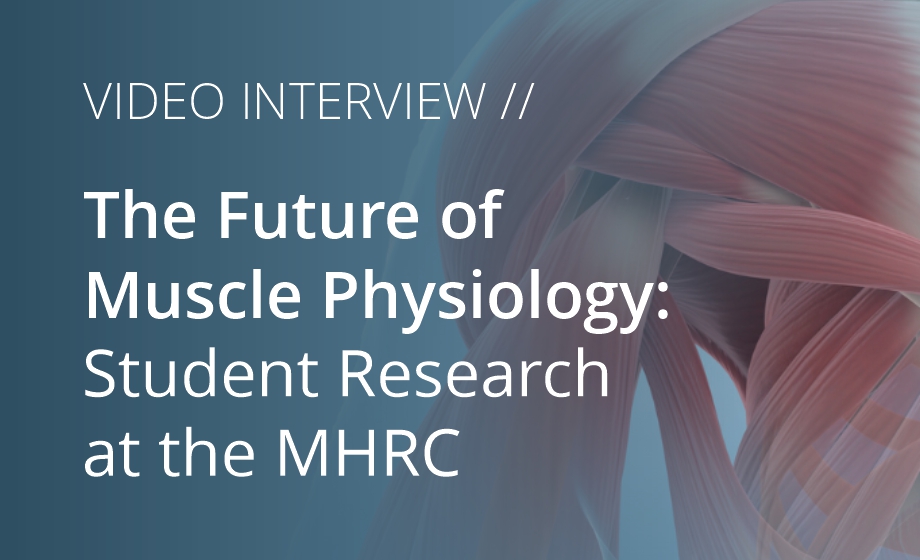Out of This World Research at Brock University: Post Mission Insights into Alterations of Soleus Muscle Function in Space-Flown Mice

From left to right: Briana Hockey, Jessica Braun, Dr. Val Fajardo.
In late 2023, we had the pleasure of sitting down with Dr. Val Fajardo, Canada Research Chair and Head of the Muscle Plasticity in Health and Disease lab at Brock University, as well as two graduate researchers in his lab – Jessica Braun and Briana Hockey. Their team were some of the first to analyze tissue samples from NASA’s SpaceX CRS-29, a commercial resupply services mission to the International Space Station (ISS) launched on November 9th. These samples from the Rodent Research-20 (RR-20) payload, which has since returned to Earth, is being examined to determine the effects of month-long space flight on female reproductive health. The RR-20 payload aims to determine whether space travel permanently or temporarily impacts the reproductive capabilities of female mice, and if resulting bone loss is associated with hormonal imbalances.
Through NASA’s Biospecimen Sharing Program, Dr. Fajardo’s lab was also able to analyze the effects of spaceflight on muscle contractility and function using cutting-edge equipment from Aurora Scientific. This project extends Dr. Fajardo’s lab’s ongoing partnership with NASA and builds on their prior research analyzing how space travel affects muscle and bone at the cellular level. Alongside other researchers from around the world, Dr. Fajardo’s group made use of the 1200B Isolated Muscle System from Aurora Scientific to analyze these recently returned samples. Hear from Dr. Fajardo, Jessica, and Briana on their post-mission experience at the Roskamp Institute, data collected, and future directions of the lab in the interviews below!
Dr. Val Fajardo
In our first interview, we spoke with Dr. Val Fajardo. Through collaboration with several of the lead scientists on the RR-20 mission, NASA scientists, and the Roskamp Institute staff, this group sought to address how muscle contractility changed after spaceflight. Analysis of whole muscle contractility after spaceflight of this duration has not yet been analyzed, and so providing this data to the NASA research community is imperative.
What we found is basically bang on with the literature.
The soleus muscle, a broad muscle in the lower calf used for posturing and stabilizing on Earth, was unused during spaceflight. This resulted in the muscle becoming unloaded, a metabolic phenomenon which is characterized by a broad shift in muscle cell type. Most muscles have a mix of slow and fast types of muscle fibers. Slow fibers are rich in mitochondria and are more resistant to fatigue than fast types of muscle fibers, which are powerful but more fatigue-sensitive. Due to the microgravity changes experienced in spaceflight, a shift from slow to fast muscle fiber types occurs, ultimately leading to greater muscle fatigue following spaceflight. This effect is not easily reversed; although some improvement was noted two weeks after recovery, the observed fatigue remained higher than usual.
So if the female mouse goes up into space and returns back to Earth, do they pass down any of these effects from spaceflight onto their pups?
While the results from RR-20 are still in preliminary analysis, Dr. Fajardo provides some highlights. Of particular interest is their investigation on the effects of microgravity on future pregnancies following copulation with non-spaceflight mice. Both male and female F1 offspring are to be analyzed in these experiments, with potentially very interesting results. Further experiments involve biochemical analysis of this effect and correlating this functional data with genomic data.
The data from the RR-20 mission experiments will be available here soon: https://osdr.nasa.gov/bio/.
Jessica Braun, PhD Candidate
Jessica Braun, a PhD candidate under Dr. Fajardo’s supervision, explains how working at the Roskamp Institute was a valuable and structured experience, contrasting with the more relaxed environment of Brock University. Despite its size, the institute boasted advanced research capabilities and required meticulous planning for resources, which was a significant learning curve.
Many exciting outcomes emerged from the projects, but especially the soleus work that provided data for NASA’s research. This collaboration and the ability to correlate direct data from muscle samples were particularly rewarding to Jessica. The ability to compare results directly from the same muscle samples should lead to significant insights.
Jessica shares that collaborating with such a wide network of researchers from different disciplines provided invaluable and unique learning opportunities. For example, together with her colleague Brianna Hockey, they had the opportunity to assist a different lab group in collecting bone samples, learning new and unfamiliar protocols. This work has provided the group with even more opportunities for interdisciplinary partnerships, demonstrating the importance of scientific collaboration.
There was already talk about potentially going back [after] another mission, working with these researchers in the future.
Briana Hockey, PhD Candidate
Briana Hockey is a second year PhD student in the Muscle Plasticity in Health and Disease Lab. Working and collaborating with notable PI’s across various disciplines at the Roskamp Institute was a particular highlight for her, noting that everyone working on these projects was very enthusiastic and welcoming. She also describes how the results obtained in this study were consistent with past literature, highlighting some exceptional findings about recovery. The results showing decrease in muscle strength along with notable outcomes regarding fatigue were expected. However, the most significant finding was the length of time for complete restoration of muscle strength and quality.
[It took] about 2 months or so until we’re actually seeing that full recovery of muscle force production and muscle quality.
The diverse and efficient workflow, with different stations for brain, gut, bone, muscle, and reproductive analysis, was impressive. Briana felt the inclusive and supportive environment, especially toward international colleagues, was a pleasant surprise, fostering an exchange of knowledge and keeping doors open for future collaborations in muscle research.
Additional Content From Aurora Scientific
We were able to produce these interviews in joint partnership with Aurora Scientific. For the last 30 years, Aurora Scientific has provided life science researchers with reliable, quality instrumentation within the fields of muscle physiology, neuroscience, and materials science. Click here to learn more about how they can support your research!
Part One interviews with Brock University’s Val Fajardo, Briana Hockey, & Jessica Braun on NASA Rodent Research-20 mission to study spaceflight effect on muscle.
This episode of Share Science features Christopher Perry, PhD, an Associate Professor at York University, who shares his career path, but also his ideas and goals to further help those with muscle disease and to provide more opportunities for his trainees.
We summarize an interview with three students from the Muscle Health Research Centre (MHRC) at York University who conduct fascinating research in the field of muscle physiology.





